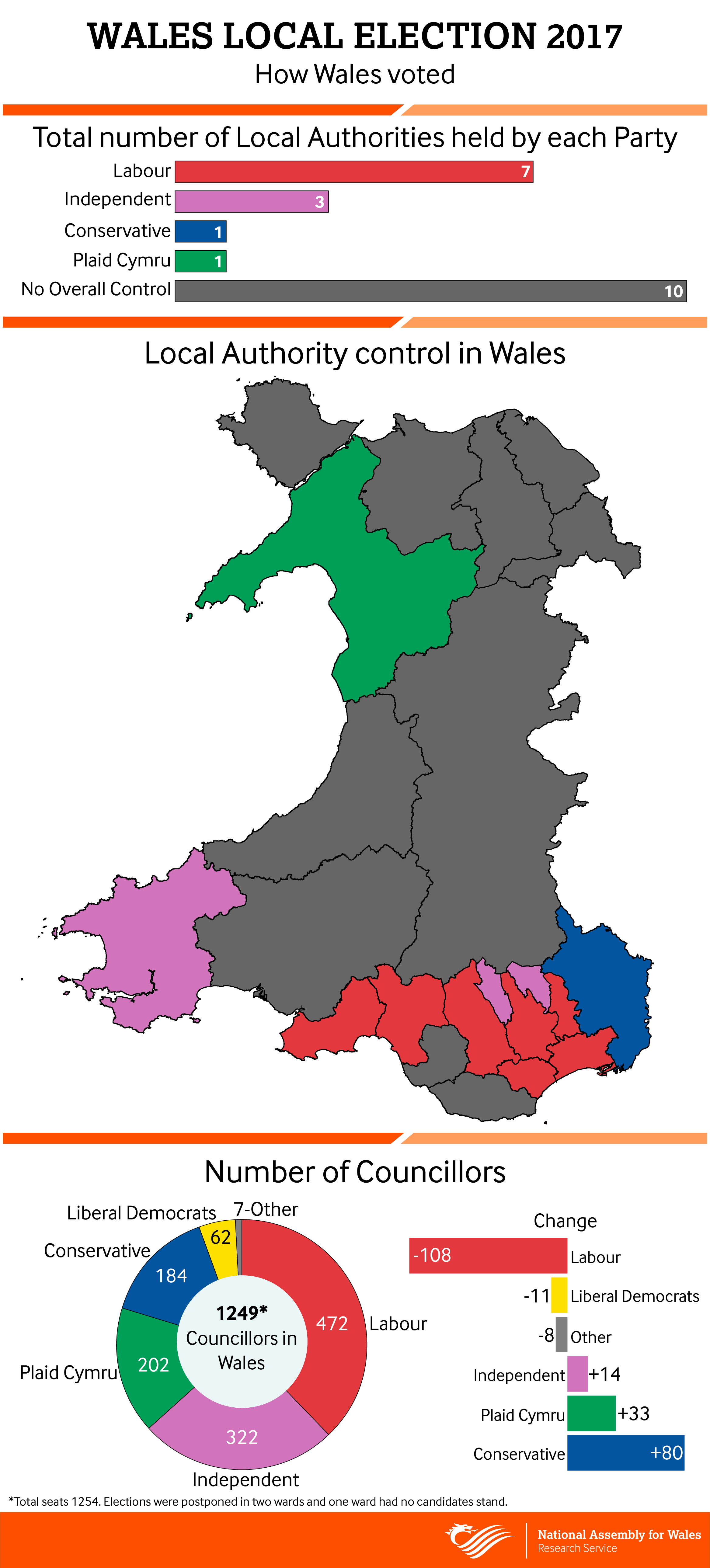On Thursday 4 May 2017, local elections were held in all 22 local authorities in Wales. Of the 1,254 seats available, 1,161 are contested, with 92 returned unopposed and one seat in Powys with no candidates standing.
Council control
The number of local authorities under the control of each party or group (i.e. where a party or group holds the majority of seats), or with no overall control following the election are outlined in the table below. 
(Note: Changes to overall control are compared with 2012 local election results (2013 for Anglesey) and do not take into account any by-elections or changes in political affiliation of councillors that may have taken place since the last election).
The Labour Party retains control of seven local authorities across Wales, but lost overall control of Blaenau Gwent, Bridgend and Merthyr Tydfil*.
Plaid Cymru gained control of Gwynedd (Plaid Cymru have controlled the council since 2015, and the Conservatives gained control of Monmouthshire.
Following the election, Independents are now the majority in both Blaenau Gwent and Merthyr Tydfil*. This is in addition to Pembrokeshire, which maintains an independent majority (as it was following the 2012 election).
As of 5 May 2017, 10 local authorities have no party or group holding overall control.
Councillors
The Labour Party has the highest number of councillors across Wales, with 472. Compared to 2012 this is a reduction of 108 councillors.
Labour saw losses in 18 local authorities, including Blaenau Gwent (-20), Rhondda Cynon Taf (-13) and Bridgend (-13).
Labour made gains in Flintshire (3) and Powys (1), and maintained its 2012 level in Ceredigion and Caerphilly. The Party also retained control of Swansea, Cardiff and Newport, despite seeing losses in each.
Independent councillors make up approximately one quarter of all councillors in Wales, with 322 seats in 2017.
The number of independent councillors increased in 13 local authorities compared to 2012, with the most significant increases in Blaenau Gwent (19), Merthyr Tydfil (9), Wrexham (7) and Gwynedd (7).
Independents lost 17 councillors in Powys, meaning they no longer have a majority and saw reductions in a further eight local authorities.
Plaid Cymru have the third largest number of council seats across Wales, with 202 elected members in 2017.
The Party increased its number of elected members by 33 compared with the 2012 election. The biggest increases came in Rhondda Cynon Taf (9), Carmarthenshire (8) and Neath Port Talbot (7). The Party saw increases in 10 other local authorities and become the largest group on Anglesey council.
Plaid Cymru saw losses in Caerphilly, Conwy, Torfaen and the Vale of Glamorgan, losing two seats in each council compared to the 2012 election (Plaid Cymru also lost one seat in Flintshire).
The Conservative Party gained the most seats compared to the 2012 election result, increasing the number of Conservative councillors from 104 in 2012 to 184 in 2017 and seeing increases in 12 local authorities. The most significant increases came in Cardiff (13), Vale of Glamorgan (12) and Bridgend (10). In Denbighshire and the Vale of Glamorgan (both no overall control) the Conservatives became the largest group.
Flintshire was the only local authority where the number of Conservative councillors decreased (-2).
The Liberal Democrats lost 11 councillors compared to 2012 and saw reductions in councillors in seven local authorities, meaning the party now has 62 councillors across Wales. The most significant losses for the Liberal Democrats were in Swansea and Cardiff (both -5); the Party also lost two seats in Flintshire, Wrexham and Bridgend. The Liberal Democrats made gains in four local authority areas including Powys (4), Ceredigion (1), Neath Port Talbot (1) and Newport (1).
UKIP, who won two seats during the 2012 election in the Vale of Glamorgan and Merthyr Tydfil, did not win any seats in 2017.
The Green Party gained one seat in 2017 in Powys. This is the Party’s first seat on the council.
*This information has been compiled immediately following the election on 4 May 2017, as such does not take into account wards where elections have been postponed and results are therefore subject to change. The elections for one Ward in Merthyr Tydfil and one ward in Ceredigion have been postponed until 8th June 2017. In the case of the Merthyr Tydfil seat, three seats are available, should Labour win these seats they would be the controlling group on the council. This information has been sourced from the BBC website and National Assembly for Wales publication – Local Elections 2012. The results for Torfaen data set-out in the BBC 2017 results have been recorded differently to the NAfW and BBC 2012 results, resulting in a one-councillor difference in the total Labour decrease.
Article by David Millett, Osian Bowyer and Owen Holzinger National Assembly for Wales Research Service.
This post is also available as a print-friendly PDF: Local elections 2017 - Results (PDF, 398KB)






